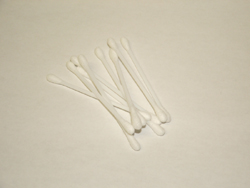Thermal Paste and How To Use It |
|
Choosing the right thermal paste
When choosing a paste for your heatsink, you have two main types that are usually considered; metal-based or ceramic-based. In most cases people use the metal-based, simply because it performs better as stated before. But nowadays, especially with GPUs, there are a lot of transistors/electrical components that are very close to the die.So when applying thermal paste, if you are not very experienced with applying it, there is a chance that when you place the heatsink, some of the paste can be squeezed out onto theses transistors/electrical components and cause a short. This is very bad of course and is a nightmare for anyone.
This is where a ceramic-based compound has the advantage. With RAM module heatsinks, ceramic-based is almost a given to use. GPUs and chipsets are also examples that you might want to use a ceramic paste on, unless you are comfortable with using metal-based. But do not use a metal-based paste on RAM. Metal-based is usually used on CPUs that have an Integrated Heat Spreader (IHS). All modern CPUs have an IHS, but some people will actually remove it to get better performance.
For brands of thermal paste, the best around are Arctic Silver, Arctic Cooling, Coollaboratory, and a few others. They make very high quality thermal materials that are the most used by end-users. You can't go wrong with these brands. Other makes will work great, but maybe not as good. For the few extra dollars that are needed for some of the more expensive brands is usually worth it.

Cleaning your chip first
If you’re installing a new heatsink before you even had a heatsink on you CPU, then there is no need to do this. But in the case of putting a new one on, or changing a video card cooler, then you must clean your chip first.For this, most used is Isopropyl Alcohol, Acetone, or a solution called ArctiClean. For using the cleaners, use non-linty cloth or Q-Tips (cotton swabs). Q-Tips are great where they're small and easy to get where you want, plus you can also see exactly what you are doing.

For Isopropyl Alcohol, the higher the percentage the better. 70% is not bad, 90% or higher is the most ideal. The reason; the higher the percentage, the quicker it will evaporate and the less residue it will leave. 99% will leave almost zero residue.


Note: Never use any oil-based cleaners, as oil will ruin your coolers performance because it adds an oil layer through which heat travels slowly.
When you have your cleaner, dip your cloth/Q-Tip in, then gently rube the surface of the chip until all the old paste is gone. You will probably have to do this more than once to get it nice and clean. It is usually a good idea to use a credit card to scrape most of the old TIM off, and then use the cleaners.



The exact same process is used to clean the CPU/GPU. Just be careful if you're cleaning the CPU out of it’s socket. If you push to hard on it, you might bend a pin.
Note: Make sure you do not touch the surface of the chip with your bare finger, as your skin has natural oils on it as well.
To remove thermal pads, use a credit card or some other plastic object (do not use a metal object as it could scratch the cooler's base). Then follow the same procedure as stated above. You want to make sure all of the old paste or thermal pad is gone, otherwise it can affect performance of the cooler.
Apr 19th, 2024 21:08 EDT
change timezone
Latest GPU Drivers
New Forum Posts
- Roccat Kone AIMO has developed a double left click, when I click it once. Any fix out there? (35)
- I just succesfully baked DDR4 (71)
- Windows 11 General Discussion (5014)
- GTX 1060 6GB ASUS GPU Shuts Down after 5min of Gaming (4)
- Official Board Game Discussion (1)
- USB C to USB A hub (42)
- The Official Linux/Unix Desktop Screenshots Megathread (688)
- AMD RX 7000 series GPU Owners' Club (1068)
- I9 13890HX undervolting Suggestions (4)
- Undervolting Dell XPS 14 9440 is it possible? (7)
Popular Reviews
- Horizon Forbidden West Performance Benchmark Review - 30 GPUs Tested
- Fractal Design Terra Review
- Corsair 2000D Airflow Review
- Thermalright Phantom Spirit 120 EVO Review
- Minisforum EliteMini UM780 XTX (AMD Ryzen 7 7840HS) Review
- Creative Pebble X Plus Review
- FiiO KB3 HiFi Mechanical Keyboard Review - Integrated DAC/Amp!
- ASUS GeForce RTX 4090 STRIX OC Review
- NVIDIA GeForce RTX 4090 Founders Edition Review - Impressive Performance
- ASUS GeForce RTX 4090 Matrix Platinum Review - The RTX 4090 Ti
Controversial News Posts
- Sony PlayStation 5 Pro Specifications Confirmed, Console Arrives Before Holidays (111)
- NVIDIA Points Intel Raptor Lake CPU Users to Get Help from Intel Amid System Instability Issues (102)
- US Government Wants Nuclear Plants to Offload AI Data Center Expansion (98)
- AMD "Strix Halo" Zen 5 Mobile Processor Pictured: Chiplet-based, Uses 256-bit LPDDR5X (84)
- Windows 10 Security Updates to Cost $61 After 2025, $427 by 2028 (82)
- Developers of Outpost Infinity Siege Recommend Underclocking i9-13900K and i9-14900K for Stability on Machines with RTX 4090 (82)
- TechPowerUp Hiring: Reviewers Wanted for Motherboards, Laptops, Gaming Handhelds and Prebuilt Desktops (72)
- Intel Realizes the Only Way to Save x86 is to Democratize it, Reopens x86 IP Licensing (70)